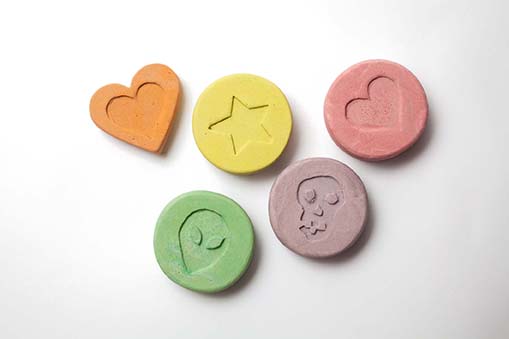
Ecstasy abuse in the workplace
Ecstasy is among the most common illegal drugs consumed in Australia. According to the 2019 National Drug Strategy Household Survey, 12.5% of Australians aged 14 years and above have used ecstasy at some point in their life.
With the high prevalence of ecstasy use and abuse, there is a high probability that users are employed, which could pose serious health and safety issues for your business.
In this article, we provide you with an overview of ecstasy, its effects, the impact of ecstasy in the workplace, and how to manage ecstasy abuse at work.
What is ecstasy?
Ecstasy or XTC is a slang term for the chemical substance called methylene-dioxy-methamphetamine or MDMA.
It was originally used by the US Army for psychological warfare tests in 1953 and as a psychotherapy aid in lowering inhibitions in 1960. It was only during the 1970s that ecstasy began to be used as a party and social drug.
Known by many different names such as the love drug, pills and pingas, ecstasy often comes in a tablet form that can easily be swallowed and consumed. These tablets come in various sizes, shapes, and colours, and are sometimes imprinted with familiar logos.
Effects of ecstasy on the body
Just like any other drug, the effects of ecstasy vary from one person to another.
Ecstasy is a member of the amphetamine family but is relatively weak compared to methamphetamine. Even so, as a stimulant, it will accelerate central nervous system activity and is a popular recreational drug because it induces altered sensations and a feeling of euphoria, as well as increasing energy, empathy and pleasure among its users and altering perception and concentration. By increasing empathy, XTC has gained a reputation as a feel-good ‘hug-drug’.
Despite its ‘good’ reputation, which explains why it is regularly used in dance parties and raves, XTC is not without some significant adverse effects. Immediate effects of ecstasy in the body may include dilated pupils, heightened sensations, clenching of jaws, grinding teeth, increased heart rate, increased confidence and energy, anxiety, sweating, nausea, loss of appetite, aggression, and psychosis. Higher dosage causes convulsions, vomiting, hallucinations, floating sensations, and irrational behaviour.
People can easily overdose on ecstasy. Overdose from ecstasy can be characterized by increased blood pressure, heightened body temperature, elevated heartbeat, and hallucinations. The rise in body temperature and the abnormally rapid heart rate are major side-effects of XTC and can be potentially lethal, being associated with markedly increased sweating which can lead to death from dehydration and an electrolyte imbalance if the user fails to adequately replenish electrolytes – especially sodium – as well as water lost through the sweat. Heart attacks, strokes from clots and brain haemorrhages and dangerously low blood sodium (leading to life-threatening fits) may occur. With the ecstatic, feel-good effects of XTC, many users don’t realize they are over-heated and dehydrated until they collapse from heat stroke.
The effects of ecstasy are even more dangerous when users ingest pills presented as ecstasy but are cut with unknown chemicals that can prove to be toxic. Many of the reported ecstasy-related injuries and deaths during raves and music festivals can be attributed to fake ecstasy tainted with dangerous impurities.
The impact of ecstasy in the workplace
As a party drug, ecstasy is most used at parties, raves, and music festivals, which usually take place over a weekend or public holidays. However, like many other illicit drugs, ecstasy stays in the body for days, which means its effects will still be felt at work.
Some workers may “drop” ecstasy at work. While it does produce an energising effect, the way the drug affects one’s perception, concentration and coordination pose a danger to the safety of the worker. In addition, workers taking ecstasy are much more vulnerable to and prone to heat prostration.
If the worker has taken a ‘fake’ ecstasy pill, they could collapse and suffer seizures and cause a workplace accident in the process.
Another concern is the way the drug affects a person’s behaviour. Users are often irrational and can suffer hallucinations, which can cause health and safety issues, and make other workers feel uncomfortable.
Signs of ecstasy abuse
Signs and signals of ecstasy abuse may include:
- Loss of inhibitions
- Unusual bursts of euphoria, and socially inappropriate physical contact/touching
- Heightened alertness and distractibility
- Very energetic
- Paranoia
- Excessive teeth grinding
- Excessive sweating
- Heightened sexuality
- Memory loss – especially of recent events or instructions.
What to do about ecstasy at work
The best protection against ecstasy abuse is a solid workplace drug and alcohol policy and procedure. The policy should include a drug and alcohol education and awareness program and a drug testing program.
Ecstasy testing
Ecstasy is one of the standard five drugs employers are required to test for within the Australian standard.
The chemical structure of the drug is similar to amphetamines, so a person who takes ecstasy at work will fail random ecstasy drug testing upon the detection of amphetamines in the system.
Urine drug testing and oral fluid (saliva) drug testing are the most common methods used for ecstasy drug testing. The drug detection window for ecstasy in oral fluid is roughly 12 to under 24 hours and for urine around 2 to 3 days.
Learn more
Safework Health can help you keep your workplace safe from drugs and alcohol. Contact us today for a confidential discussion.
